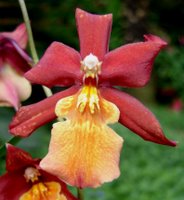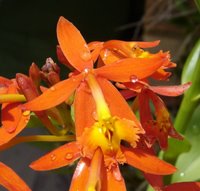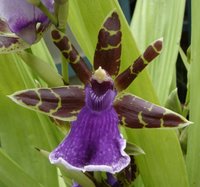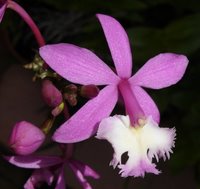
27 February 2006
26 February 2006
Oligonucleotidal wave
So here I am, trying to organize oligonucleotides into a spreadsheet that makes absolutely no sense. This spreadsheet, when I've finally given birth to it, will be a central database for clones and PCR primers used by our research group. Somehow, I've been commandeered to 'take care' of the chaos within all of the fridges that belong to the group. This entails not only defrosting them, but also throwing stuff away that's been growing in them since, oh, I don't know, possibly the late 80's.
My problem is this: once you've shown the ability to organize stuff, together with a can-do attitude (inherited from my people-pleaser father, I'm sure) everyone else just sits back and expects me to fix stuff. Aaargh!! What they've all failed to realize is that I'm actually not a nice person, am inherently selfish and just don't do favours. If it wasn't for my obsessive compulsiveness, I would've sent them all to hell by now. The fact is that I like order. I like lists. What I don't like is people abusing this weakness of mine so that I make lists for them. Make your own lists, damn you! I know they won't be anything as efficient and ordered as mine, but make them nevertheless. I'm now struggling to make sense of things acquired for the lab before I even came here. Hundreds and hundreds of references to little bits of synthetic DNA ordered from biotech companies that went bust when WindowsXP was but a dream, ordered for students who probably graduated when I mistakenly thought science would be a great career move after seeing this new Jurassic Park movie.
This has to stop.
My problem is this: once you've shown the ability to organize stuff, together with a can-do attitude (inherited from my people-pleaser father, I'm sure) everyone else just sits back and expects me to fix stuff. Aaargh!! What they've all failed to realize is that I'm actually not a nice person, am inherently selfish and just don't do favours. If it wasn't for my obsessive compulsiveness, I would've sent them all to hell by now. The fact is that I like order. I like lists. What I don't like is people abusing this weakness of mine so that I make lists for them. Make your own lists, damn you! I know they won't be anything as efficient and ordered as mine, but make them nevertheless. I'm now struggling to make sense of things acquired for the lab before I even came here. Hundreds and hundreds of references to little bits of synthetic DNA ordered from biotech companies that went bust when WindowsXP was but a dream, ordered for students who probably graduated when I mistakenly thought science would be a great career move after seeing this new Jurassic Park movie.
This has to stop.
20 February 2006
In The Greenhouse (06/02)
This has been a very wet month. The plants from cloud forests, such as Masdevallia, Pescatorea and Bulbophyllum, have shown their appreciation by exploding with new growth and flowers. February is usually a rather quiet time of year, but I have a number of special things to share with you.
 Burrageara Stefan Isler. An intergeneric hybrid in the Oncidinae (Cochlioda x Miltonia x Odontoglossum x Oncidium). This initially produced two spikes, but a thunderstorm left me with one flowerspike of 5 flowers. Stefan Isler is an old hybrid really, and its only redeeming feature in the 21st century is the intensity of its coloration: the flowers are smallish compared to modern hybrids and have very poor shape, the curving petals reducing the overall size almost by half.
Burrageara Stefan Isler. An intergeneric hybrid in the Oncidinae (Cochlioda x Miltonia x Odontoglossum x Oncidium). This initially produced two spikes, but a thunderstorm left me with one flowerspike of 5 flowers. Stefan Isler is an old hybrid really, and its only redeeming feature in the 21st century is the intensity of its coloration: the flowers are smallish compared to modern hybrids and have very poor shape, the curving petals reducing the overall size almost by half.
 Cymbidium Summer Pearl 'Senna'. A miniature cymbidium with pale green blooms of full shape. This grex is unusual for its capacity for summer flowering, a time rarely graced by cymbidiums. The individual in the photo produced 7 flowers on one spike (which snapped soon after, when raindrops collecting on the flowers increased the weight of the whole thing beyond the capabilities of the spike).
Cymbidium Summer Pearl 'Senna'. A miniature cymbidium with pale green blooms of full shape. This grex is unusual for its capacity for summer flowering, a time rarely graced by cymbidiums. The individual in the photo produced 7 flowers on one spike (which snapped soon after, when raindrops collecting on the flowers increased the weight of the whole thing beyond the capabilities of the spike).
 Epidendrum radicans. People always confuse this reedstem with Epi. ibaguense, which looks very similar. However, radicans has resupinate flowers (i.e. lip lowermost) and a (quite annoying) scrambling habit with aerial roots produced along almost the whole length of the cane. The particular individual pictured here has interconnected stems in three separate containers, a jumble of keikis and roots. Forget Gordian's knot, try repotting one of these.
Epidendrum radicans. People always confuse this reedstem with Epi. ibaguense, which looks very similar. However, radicans has resupinate flowers (i.e. lip lowermost) and a (quite annoying) scrambling habit with aerial roots produced along almost the whole length of the cane. The particular individual pictured here has interconnected stems in three separate containers, a jumble of keikis and roots. Forget Gordian's knot, try repotting one of these.
 Zygopetalum Everspring 'Hollandia'. With 29 flowers on five flowerspikes, this is definitely the star orchid of the month. I finally cracked the secret to growing this very leafy orchid when I moved it from its previous aspect under shade net outdoors and placed it on the highest shelf in the greenhouse. Here it received incredibly bright light short of burning, constantly moving air from a fan and a regular watering regime, resulting in vigorous growth and flower production. This hybrid has incredibly intense colours: dark brown barring on fresh green petals and sepals, and a violet-blue lip with pure white background. Although photos often lie, the colours here are pretty accurate. Spidery and sinister, a Gothic romance, this is my kind of orchid.
Zygopetalum Everspring 'Hollandia'. With 29 flowers on five flowerspikes, this is definitely the star orchid of the month. I finally cracked the secret to growing this very leafy orchid when I moved it from its previous aspect under shade net outdoors and placed it on the highest shelf in the greenhouse. Here it received incredibly bright light short of burning, constantly moving air from a fan and a regular watering regime, resulting in vigorous growth and flower production. This hybrid has incredibly intense colours: dark brown barring on fresh green petals and sepals, and a violet-blue lip with pure white background. Although photos often lie, the colours here are pretty accurate. Spidery and sinister, a Gothic romance, this is my kind of orchid.
 Burrageara Nelly Isler. One of the progeny of Burr. Stefan Isler, this is superior in every way, bearing larger and more rounded flowers with more intricate, hideously kitschy patterning. The combination of bright orange spots with a delicate coral pink background are particularly nauseating. The tiny plant in my collection produced three spikes with a total of 9 flowers, almost completely obscuring the foliage. The blooms are nice and flat, not so recurved as in Stefan Isler.
Burrageara Nelly Isler. One of the progeny of Burr. Stefan Isler, this is superior in every way, bearing larger and more rounded flowers with more intricate, hideously kitschy patterning. The combination of bright orange spots with a delicate coral pink background are particularly nauseating. The tiny plant in my collection produced three spikes with a total of 9 flowers, almost completely obscuring the foliage. The blooms are nice and flat, not so recurved as in Stefan Isler.
 Epicattleya Nebo. Bright pink starry flowers are produced in profusion on this compact reedstem. Any cattleya influence is virtually drowned out by the influence of the epidendrum parents, apart from the crenellated labellum and slightly larger size of the flowers than other reedstem epis.
Epicattleya Nebo. Bright pink starry flowers are produced in profusion on this compact reedstem. Any cattleya influence is virtually drowned out by the influence of the epidendrum parents, apart from the crenellated labellum and slightly larger size of the flowers than other reedstem epis.
Next month: expect images of several Thai-bred hardcane dendrobiums, Epidendrum ciliare and some of the weirder things in my collection.
 Burrageara Stefan Isler. An intergeneric hybrid in the Oncidinae (Cochlioda x Miltonia x Odontoglossum x Oncidium). This initially produced two spikes, but a thunderstorm left me with one flowerspike of 5 flowers. Stefan Isler is an old hybrid really, and its only redeeming feature in the 21st century is the intensity of its coloration: the flowers are smallish compared to modern hybrids and have very poor shape, the curving petals reducing the overall size almost by half.
Burrageara Stefan Isler. An intergeneric hybrid in the Oncidinae (Cochlioda x Miltonia x Odontoglossum x Oncidium). This initially produced two spikes, but a thunderstorm left me with one flowerspike of 5 flowers. Stefan Isler is an old hybrid really, and its only redeeming feature in the 21st century is the intensity of its coloration: the flowers are smallish compared to modern hybrids and have very poor shape, the curving petals reducing the overall size almost by half. Cymbidium Summer Pearl 'Senna'. A miniature cymbidium with pale green blooms of full shape. This grex is unusual for its capacity for summer flowering, a time rarely graced by cymbidiums. The individual in the photo produced 7 flowers on one spike (which snapped soon after, when raindrops collecting on the flowers increased the weight of the whole thing beyond the capabilities of the spike).
Cymbidium Summer Pearl 'Senna'. A miniature cymbidium with pale green blooms of full shape. This grex is unusual for its capacity for summer flowering, a time rarely graced by cymbidiums. The individual in the photo produced 7 flowers on one spike (which snapped soon after, when raindrops collecting on the flowers increased the weight of the whole thing beyond the capabilities of the spike).  Epidendrum radicans. People always confuse this reedstem with Epi. ibaguense, which looks very similar. However, radicans has resupinate flowers (i.e. lip lowermost) and a (quite annoying) scrambling habit with aerial roots produced along almost the whole length of the cane. The particular individual pictured here has interconnected stems in three separate containers, a jumble of keikis and roots. Forget Gordian's knot, try repotting one of these.
Epidendrum radicans. People always confuse this reedstem with Epi. ibaguense, which looks very similar. However, radicans has resupinate flowers (i.e. lip lowermost) and a (quite annoying) scrambling habit with aerial roots produced along almost the whole length of the cane. The particular individual pictured here has interconnected stems in three separate containers, a jumble of keikis and roots. Forget Gordian's knot, try repotting one of these.  Zygopetalum Everspring 'Hollandia'. With 29 flowers on five flowerspikes, this is definitely the star orchid of the month. I finally cracked the secret to growing this very leafy orchid when I moved it from its previous aspect under shade net outdoors and placed it on the highest shelf in the greenhouse. Here it received incredibly bright light short of burning, constantly moving air from a fan and a regular watering regime, resulting in vigorous growth and flower production. This hybrid has incredibly intense colours: dark brown barring on fresh green petals and sepals, and a violet-blue lip with pure white background. Although photos often lie, the colours here are pretty accurate. Spidery and sinister, a Gothic romance, this is my kind of orchid.
Zygopetalum Everspring 'Hollandia'. With 29 flowers on five flowerspikes, this is definitely the star orchid of the month. I finally cracked the secret to growing this very leafy orchid when I moved it from its previous aspect under shade net outdoors and placed it on the highest shelf in the greenhouse. Here it received incredibly bright light short of burning, constantly moving air from a fan and a regular watering regime, resulting in vigorous growth and flower production. This hybrid has incredibly intense colours: dark brown barring on fresh green petals and sepals, and a violet-blue lip with pure white background. Although photos often lie, the colours here are pretty accurate. Spidery and sinister, a Gothic romance, this is my kind of orchid. Burrageara Nelly Isler. One of the progeny of Burr. Stefan Isler, this is superior in every way, bearing larger and more rounded flowers with more intricate, hideously kitschy patterning. The combination of bright orange spots with a delicate coral pink background are particularly nauseating. The tiny plant in my collection produced three spikes with a total of 9 flowers, almost completely obscuring the foliage. The blooms are nice and flat, not so recurved as in Stefan Isler.
Burrageara Nelly Isler. One of the progeny of Burr. Stefan Isler, this is superior in every way, bearing larger and more rounded flowers with more intricate, hideously kitschy patterning. The combination of bright orange spots with a delicate coral pink background are particularly nauseating. The tiny plant in my collection produced three spikes with a total of 9 flowers, almost completely obscuring the foliage. The blooms are nice and flat, not so recurved as in Stefan Isler. Epicattleya Nebo. Bright pink starry flowers are produced in profusion on this compact reedstem. Any cattleya influence is virtually drowned out by the influence of the epidendrum parents, apart from the crenellated labellum and slightly larger size of the flowers than other reedstem epis.
Epicattleya Nebo. Bright pink starry flowers are produced in profusion on this compact reedstem. Any cattleya influence is virtually drowned out by the influence of the epidendrum parents, apart from the crenellated labellum and slightly larger size of the flowers than other reedstem epis. Next month: expect images of several Thai-bred hardcane dendrobiums, Epidendrum ciliare and some of the weirder things in my collection.
11 February 2006
Technology slapping me up the side of the head once again
I've been trying to put up the latest In The Greenhouse post, but the net settings at the lab (which is where I abuse the facilities to provide you all with these aimless ramblings) have been altered, preventing me from uploading any images. That's a long opening sentence. Anyhow, I'll just keep trying; i actually have enough images for two postings by now. Would love to share my photographs of Dendrobium bigibbum var compactum and Gongora galeata, as well as some vivid Burrageara hybrids. All I wanted was to add some beauty to the world.
Subscribe to:
Posts (Atom)
